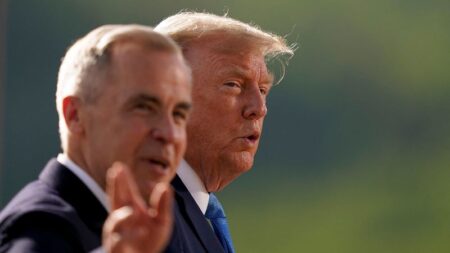In a significant shift in trade relations, Canada has decided to withdraw its planned digital services tax (DST) targeting major U.S. tech companies. This move comes just hours before the tax was set to take effect, a decision made to facilitate the resumption of trade negotiations between Canada and the United States. The announcement was particularly notable as it followed U.S. President Donald Trump’s cancellation of ongoing negotiations, during which he characterized the proposed tax as a “blatant attack” on American businesses.
The digital services tax, initially scheduled to be implemented, was designed to impose a 3% charge on revenues in Canada for U.S. tech giants such as Amazon, Meta, Google, and Apple that exceed $20 million. The legislation aimed to address concerns that many large technology companies operating within Canada were not adequately contributing to the tax base. In his statement, Canada’s Finance Minister François-Philippe Champagne outlined that the tax was initially introduced in 2020 as a response to this perceived inequity.
In response to the growing pressure from the U.S. government, Canada has scrapped the DST in hopes of reigniting favorable trade discussions. Champagne asserted that Canada’s preference remains for a multilateral agreement on digital services taxation rather than unilaterally taxing foreign technology firms. This perspective aligns with global trends, as many countries—including the United Kingdom—are re-evaluating their tax structures to ensure that multinational tech firms contribute a fair share of taxes relative to their local operations and revenues.
The implications of the Canadian tax reversal resonate in a broader context regarding trade relations. Estimates suggested that the digital services tax could have imposed over $2 billion in additional costs annually on these tech giants. Trump’s administration has consistently pushed back against such taxes, arguing that they disproportionally target American companies. President Trump has built close relationships with tech owners during his time in office, and any perceived attacks on these companies are met with significant resistance from his administration.
Amidst ongoing tensions, Canada must navigate a complex trade landscape, with around 75% of its goods exports directed to the U.S., amounting to over $400 billion annually. Conversely, Canada consumes only about 17% of U.S. production. The historical context of U.S.-Canada relations has been tumultuous, characterized by shifts in policy and aggressive posturing from various leaders. Trump’s earlier threats implied potential tariffs and even discussions around potentially annexing Canada, signaling the high stakes involved in maintaining a stable and mutually beneficial trade relationship.
The current political climate appears to be attempting to mend the frayed relations, particularly amid public outcry over tariffs and trade barriers. After the Liberal Party, under the leadership of former central banker Mark Carney, gained ground amidst the rising tensions, signs of rapprochement have emerged. Both nations have indicated a desire to finalize new trade terms by July 21, aiming to mitigate uncertainties hanging over their economic interactions.
Canada’s recent reversal is not merely a matter of tax policy but a strategic recalibration intended to maintain a pathway for negotiations beneficial to both sides. The international scene is increasingly complex as countries grapple with how to fairly tax digital industries that transcend national borders while balancing national interests and international cooperation. This evolving narrative reflects not just economic factors but also the intricate dynamics of diplomacy, global influence, and the domestic pressures that shape governmental decisions.
In summary, Canada’s decision to drop the digital services tax underscores the delicate balance in U.S.-Canada trade negotiations while highlighting larger conversations about the taxation of digital businesses across the globe. Understanding these interactions is vital for anticipating future developments in international trade and economic policy.











